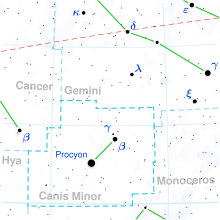astro.wikisort.org - Star
Gamma Canis Minoris (γ Canis Minoris) is a binary star system in the equatorial constellation Canis Minor. Its orange colour is obvious when seen through binoculars.[7] The system is visible to the naked eye with a combined apparent visual magnitude of +4.33.[2] Based upon an annual parallax shift of 10.25 mas as seen from Earth,[1] this system is located about 320 light years from the Sun.
 | |
| Observation data Epoch J2000.0 Equinox J2000.0 (ICRS) | |
|---|---|
| Constellation | Canis Minor |
| Right ascension | 07h 28m 09.79333s[1] |
| Declination | +08° 55′ 31.9068″[1] |
| Apparent magnitude (V) | +4.33[2] (4.46 + 6.66)[2] |
| Characteristics | |
| Spectral type | K3 III Fe-0.5[3] (K4 III + K1: III)[2] |
| U−B color index | +1.53[4] |
| B−V color index | +1.43[4] |
| Astrometry | |
| Radial velocity (Rv) | 46.8±0.3[5] km/s |
| Proper motion (μ) | RA: −61.09[1] mas/yr Dec.: −10.70[1] mas/yr |
| Parallax (π) | 10.25 ± 0.47 mas[1] |
| Distance | 320 ± 10 ly (98 ± 4 pc) |
| Absolute magnitude (MV) | −0.5±0.1[2] |
| Absolute magnitude (MV) | 1.7±0.2[2] |
| Orbit[2] | |
| Period (P) | 389.310 ± 0.012d |
| Semi-major axis (a) | 17 mas |
| Eccentricity (e) | 0.25856 ± 0.00039 |
| Inclination (i) | 66° |
| Periastron epoch (T) | 2449849.172 ± 0.089 HJD |
| Argument of periastron (ω) (secondary) | 142.079 ± 0.090° |
| Semi-amplitude (K1) (primary) | 21.243 ± 0.010 km/s |
| Semi-amplitude (K2) (secondary) | 21.526 ± 0.017 km/s |
| Details[2] | |
| γ CMi A | |
| Mass | 1.88 M☉ |
| Radius | 36.8±2.6 R☉ |
| Luminosity | 321±33 L☉ |
| Temperature | 4,036±100 K |
| Rotational velocity (v sin i) | 5±2 km/s |
| Age | 1.3 Gyr |
| γ CMi B | |
| Mass | 1.85 M☉ |
| Radius | 7.8±1.0 R☉ |
| Luminosity | 25.4±5.2 L☉ |
| Temperature | 4,658±200 K |
| Rotational velocity (v sin i) | 2.0±2.0 km/s |
| Other designations | |
| Database references | |
| SIMBAD | data |
This spectroscopic binary star system has an orbital period of 389.31 days, a semimajor axis of 1.48 AU, and an eccentricity of 0.2586.[2] Their variable radial velocity was discovered by H. M. Reese in 1902 at Lick Observatory.[8] Both components are evolved, K-type giant stars, most likely on their first ascent along the red giant branch. The primary, component A, has a stellar classification of K4 III while the secondary, component B, may be K1: III.[2]
References
- van Leeuwen, F. (2007), "Validation of the new Hipparcos reduction", Astronomy and Astrophysics, 474 (2): 653–664, arXiv:0708.1752, Bibcode:2007A&A...474..653V, doi:10.1051/0004-6361:20078357, S2CID 18759600.
- Fekel, F. C.; et al. (March 2013), "The spectroscopic orbit of the K-giant binary γ Canis Minoris", Astronomische Nachrichten, 334 (3): 223, Bibcode:2013AN....334..223F, CiteSeerX 10.1.1.300.8819, doi:10.1002/asna.201211842.
- Keenan, Philip C.; McNeil, Raymond C. (1989), "The Perkins catalog of revised MK types for the cooler stars", Astrophysical Journal Supplement Series, 71: 245, Bibcode:1989ApJS...71..245K, doi:10.1086/191373.
- Johnson, H. L. (1966), "UBVRIJKL Photometry of the Bright Stars", Communications of the Lunar and Planetary Laboratory, 4: 99, Bibcode:1966CoLPL...4...99J.
- de Bruijne, J. H. J.; Eilers, A.-C. (October 2012), "Radial velocities for the HIPPARCOS-Gaia Hundred-Thousand-Proper-Motion project", Astronomy & Astrophysics, 546: 14, arXiv:1208.3048, Bibcode:2012A&A...546A..61D, doi:10.1051/0004-6361/201219219, S2CID 59451347, A61.
- "gam CMi". SIMBAD. Centre de données astronomiques de Strasbourg. Retrieved 2017-09-03.
{{cite web}}: CS1 maint: postscript (link) - Kambič, Bojan (2009). Viewing the Constellations with Binoculars: 250+ Wonderful Sky Objects to See and Explore. Springer. p. 32. ISBN 978-0387853543.
- Campbell, W. W. (September 1902), "Six stars whose velocities in the line of sight are variable", Astrophysical Journal, 16: 114–117, Bibcode:1902ApJ....16..114C, doi:10.1086/140954.
На других языках
- [en] Gamma Canis Minoris
[ru] Гамма Малого Пса
Гамма Малого Пса (γ CMi / γ Canis Minoris) — двойная звезда в созвездии Малого Пса. Расстояние до Земли составляет 398 световых лет.Другой контент может иметь иную лицензию. Перед использованием материалов сайта WikiSort.org внимательно изучите правила лицензирования конкретных элементов наполнения сайта.
WikiSort.org - проект по пересортировке и дополнению контента Википедии